
The Bottom Line
Introduction
ASUS is always a brand gamers and enthusiasts can trust, so when it comes to the latest and not-so-greatest RTX 2080 SUPER from NVIDIA, you shouldn't be surprised that ASUS kicks some serious ass with SUPER cards, too.
NVIDIA has a fine card with its own GeForce RTX 2080 SUPER Founders Edition but there is always room for improvement -- cooling, noise levels, overclocking headroom, and more. This is where custom board partners come into play, with ASUS offering a multitude of different RTX 2080 Ti cards with its flagship Republic of Gamers brand being tested here today.
Most of the custom cards over the last few years have been very similar in performance with the big difference between the cards coming down (mostly) to cooling and style.
Detailed Specs
ASUS provide two different OC modes wiht the RTX 2080 SUPER ROG STRIX: with the default mode being 'Gaming Mode' and then another 'OC Mode' is on offer which bumps up the GPU clocks.
Gaming Mode has base GPU clocks of 1650MHz and boosts up to 1860MHz while the OC Mode ramps up the base clock to 1680MHz and the boost GPU clocks up to 1890MHz. You will obviously see much higher GPU boost clocks than this, with even more for some OC headroom if you want to tinker around with it (that's why you'd buy this card).
Cooling Tech
Breaking down the card we see that ASUS puts in a ton of effort into the RTX 2080 SUPER ROG STRIX, with a reinforced frame, axial-tech fan design and MaxContact Technology. We have 'Auto-Extreme Technology with Super Allow Power II' and Aura Sync RGB lighting on the backplate (which looks slick).
ASUS is using Axial-tech fan design on the RTX 2080 SUPER ROG STRIX graphics card. The 0dB technology means the fans won't spin up until the card is hot enough that it needs them, while the 2.7-slot design is pretty self-explanatory.
ASUS uses precision automated manufacturing which ensures you get a high-quality card that is also better on the environment.
ASUS loads up the RTX 2080 SUPER ROG STRIX with premium capacitors, DrMOS power stages, and alloy-core chokes that ensure you can get your card pushed to the max.
MaxContact is an "industry-first technology" that sees ASUS use precision machining to create a heat spreader surface that has 2x the contact with the GPU than traditional coolers.
Detailed Look
ASUS has one of the better-looking boxes of the bunch of RTX 2080 SUPER graphics cards, with the ROG STRIX getting some gorgeous box art treatment both on the front, and the back.
Hey there, beautiful. ASUS uses a triple-fan cooling rig on the RTX 2080 SUPER ROG STRIX.
I seriously love the style of backplate used here by ASUS... which looks even better in my gaming PC and lit up with Aura Sync RGB lighting.
From the top, we can see it's a 2.7-slot card with dual 8-pin PCIe power connectors.
It's a pretty thick card, but then again all of the custom RTX 2080 SUPER graphics cards are.
The 8+8-pin PCIe power connectors and a closer look at the chunky HSF.
From the end of the card.
On the other end of the card is display connectivity, which falls in the form of 2 x DP, 2 x HDMI, and 1 x VirtualLink.
You can throw the ASUS RTX 2080 SUPER ROG STRIX into SLI/NVLink if you want to, too.
Test System Specs
Our New GPU Test Rig
Welcome to the latest revision of our GPU test bed, with our system being upgraded from the Intel Core i7-7700K to the Core i7-8700K. The CPU is cooled by the Corsair H115i PRO cooler, with the 8700K overclocked to 5GHz. We've stayed with GIGABYTE for our motherboard with their awesome Z370 AORUS Gaming 7.
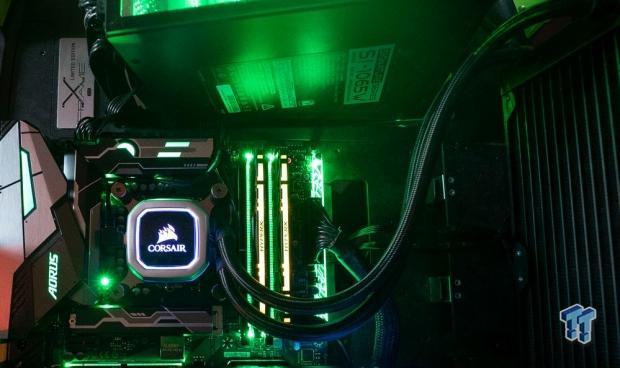
We approached our friends at HyperX for a kit of their kick ass HyperX Predator DDR4-2933MHz RAM (HX429C15PB3AK4/32), with 2 x 8GB sticks for a total of 16GB DDR4-2933. The RAM stands out through every minute of our testing as it has beautiful RGB lights giving the system a slick look while benchmarking our lives away, while the Z370 AORUS Gaming 7 motherboard joins in with its own array of RGB lighting.

Detailed Tech Specs
- CPU: Intel Core i7-8700K @ 5GHz
- Cooler: Corsair Hydro Series H115i PRO
- MB: Z370 AORUS Gaming 7
- RAM: 16GB (2x8GB) HyperX Predator DDR4-2933
- SSD: 1TB OCZ RD400 NVMe M.2
- SSD: 512GB OCZ RD400 NVMe M.2
- PSU: InWin 1065W PSU
- Chassis: In Win X-Frame
- OS: Windows 10 Pro x64
Additional Images
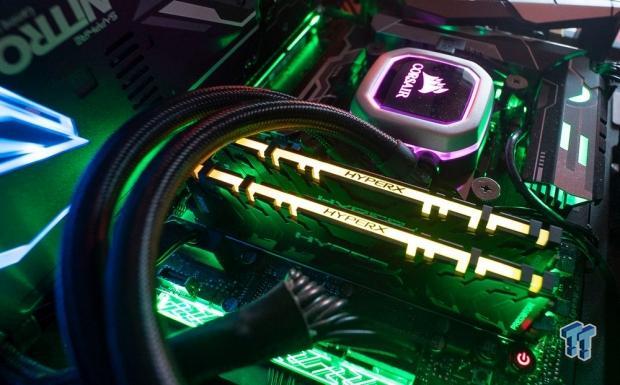
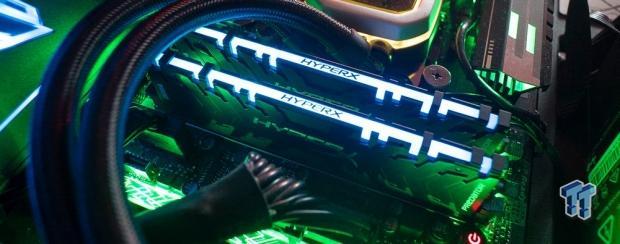
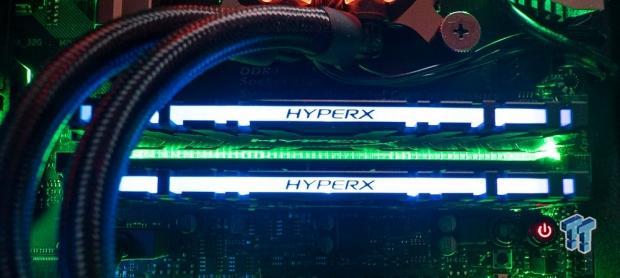
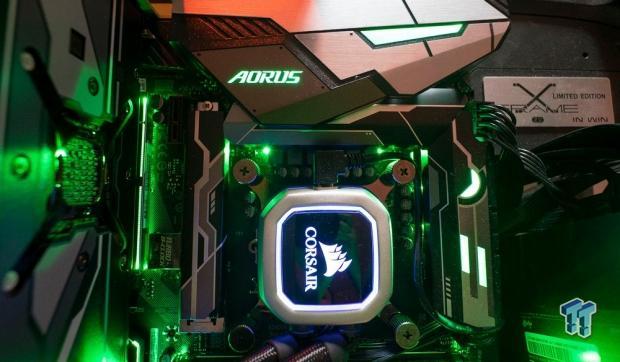
Benchmarks - Synthetic
3DMark Fire Strike - 1080p
3DMark has been a staple benchmark for years now, all the way back to when The Matrix was released and Futuremark had bullet time inspired benchmarks. 3DMark is the perfect tool to see if your system - most important, your CPU and GPU - is performing as it should. You can search results for your GPU, to see if it falls in line with other systems based on similar hardware.
3DMark Fire Strike - 1440p
3DMark has been a staple benchmark for years now, all the way back to when The Matrix was released and Futuremark had bullet time inspired benchmarks. 3DMark is the perfect tool to see if your system - most important, your CPU and GPU - is performing as it should. You can search results for your GPU, to see if it falls in line with other systems based on similar hardware.
3DMark Fire Strike - 4K
3DMark has been a staple benchmark for years now, all the way back to when The Matrix was released and Futuremark had bullet time inspired benchmarks. 3DMark is the perfect tool to see if your system - most important, your CPU and GPU - is performing as it should. You can search results for your GPU, to see if it falls in line with other systems based on similar hardware.
3DMark TimeSpy
3DMark TimeSpy Extreme
Heaven - 1080p
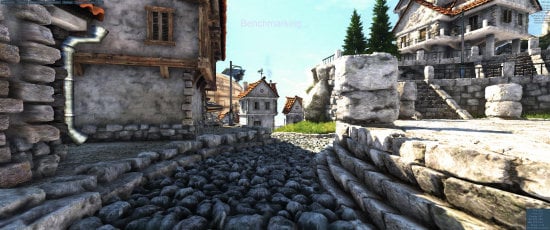
Heaven is an intensive GPU benchmark that really pushes your silicon to its limits. It's another favorite of ours as it has some great scaling for multi-GPU testing, and it's great for getting your GPU to 100% for power and noise testing.
Heaven - 1440p
Heaven - 4K
Benchmarks - 1080p
1080p Benchmarks
Middle-earth: Shadow of War is a sequel to the popular Shadow of Mordor, which was powered by the Lithtech engine. When cranked up to maximum detail, it will chew through your GPU and its VRAM like it's nothing.
You can buy Middle-earth: Shadow of War at Amazon.
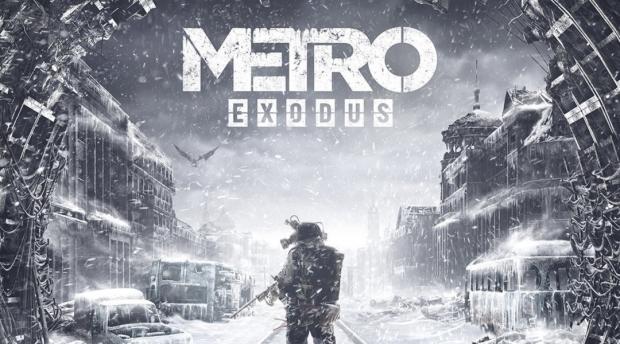
Metro Exodus is one of the hardest tests that our graphics cards have to go through, with 4A Games' latest creation being one of the best looking games on the market. It is a serious test that pushes GPUs to their limits, and also features RTX technologies like DLSS.

Far Cry New Dawn was developed by Ubisoft, and is powered the Dunia Engine, an engine that has been modified over the years for Far Cry and last used in Far Cry 5. Dunia Engine itself was a modified version of CRYENGINE, scaling incredibly well on all sorts of hardware.
Shadow of the Tomb Raider is one of the latest games to join our graphics card benchmark lineup, with the game built using the Foundation engine as a base, the same engine in Rise of the Tomb Raider. Eidos Montreal R&D department made lots of changes to the engine during the development of Shadow of the Tomb Raider to make it one of the best-looking games out right now.
Benchmarks - 1440p
1440p Benchmarks
Middle-earth: Shadow of War is a sequel to the popular Shadow of Mordor, which was powered by the Lithtech engine. When cranked up to maximum detail, it will chew through your GPU and its VRAM like it's nothing.
You can buy Middle-earth: Shadow of War at Amazon.

Metro Exodus is one of the hardest tests that our graphics cards have to go through, with 4A Games' latest creation being one of the best looking games on the market. It is a serious test that pushes GPUs to their limits, and also features RTX technologies like DLSS.

Far Cry New Dawn was developed by Ubisoft, and is powered the Dunia Engine, an engine that has been modified over the years for Far Cry and last used in Far Cry 5. Dunia Engine itself was a modified version of CRYENGINE, scaling incredibly well on all sorts of hardware.
Shadow of the Tomb Raider is one of the latest games to join our graphics card benchmark lineup, with the game built using the Foundation engine as a base, the same engine in Rise of the Tomb Raider. Eidos Montreal R&D department made lots of changes to the engine during the development of Shadow of the Tomb Raider to make it one of the best-looking games out right now.
Benchmarks - 4K
4K Benchmarks
Middle-earth: Shadow of War is a sequel to the popular Shadow of Mordor, which was powered by the Lithtech engine. When cranked up to maximum detail, it will chew through your GPU and its VRAM like it's nothing.
You can buy Middle-earth: Shadow of War at Amazon.

Metro Exodus is one of the hardest tests that our graphics cards have to go through, with 4A Games' latest creation being one of the best looking games on the market. It is a serious test that pushes GPUs to their limits, and also features RTX technologies like DLSS.

Far Cry New Dawn was developed by Ubisoft, and is powered the Dunia Engine, an engine that has been modified over the years for Far Cry and last used in Far Cry 5. Dunia Engine itself was a modified version of CRYENGINE, scaling incredibly well on all sorts of hardware.
Shadow of the Tomb Raider is one of the latest games to join our graphics card benchmark lineup, with the game built using the Foundation engine as a base, the same engine in Rise of the Tomb Raider. Eidos Montreal R&D department made lots of changes to the engine during the development of Shadow of the Tomb Raider to make it one of the best-looking games out right now.
Thermals & Power
Thermals
ASUS keeps things hella-chilled on the RTX 2080 SUPER ROG STRIX... so much so it's the coolest card in our entire chart at just 62C.
Power
It falls right into line with our whole system power consumption, with my Core i7-8700K test bed with the ASUS RTX 2080 SUPER ROG STRIX using 320W in total -- 10W short of the custom RX 5700 XT and 10W under the RTX 2080 SUPER Founders Edition from NVIDIA.
Final Thoughts
Another ROG STRIX card, another home run for ASUS. The new ASUS GeForce RTX 2080 SUPER ROG STRIX is another great card to join the ROG ranks, something that will have a great place in your gaming PC.
It has a great-looking triple-fan cooler, super-cool operation (just 62C under load) and has room to breathe when it comes to overclocking. It keeps up with other custom RTX 2080 SUPER cards (they're all going to be roughly the same) but stands out on its own with its style, design, and temps.
Performance wise it is a champion, carving through games at 1440p, 3440x1440, and even 4K without a problem. I'm a heavy Apex Legends and Overwatch player, and the ASUS RTX 2080 SUPER ROG STRIX handles those types of games at 120FPS or higher without a problem.
I even got a bunch of play time with the ASUS ROG Swift PG35VQ (my review here) -- their beasty 3440x1440 @ 200Hz G-SYNC ULTIMATE gaming monitor. I teamed the ASUS GeForce RTX 2080 SUPER ROG STRIX with it for just over a week of gaming and it was an awesome one-two punch combo.
You won't be getting 200FPS+ at 3440x1440 on an RTX 2080 SUPER, hell even the TITAN RTX (which costs $2499) can't handle that in the latest games. But, esports games shouldn't be an issue -- so if you were playing CS:GO or Overwatch on it, you're going to have an amazing time with that combination.
Performance (overclocking, power) |
95% |
Quality (build, design, cooling) |
95% |
General Features (display outputs, etc) |
95% |
Bundle, Packaging & Software |
95% |
Overall |
95% |
ASUS doesn't disappoint with its new custom GeForce RTX 2080 SUPER graphics card, dunked in that delicious ROG STRIX flavoring and pasted all over. Yum.

What's in Anthony's PC?
- CPU: Intel Core i5-12600K
- MOTHERBOARD: GIGABYTE Z690 AERO-G
- RAM: Corsair 32GB DDR4-3200
- GPU: NVIDIA GeForce RTX 4090 24GB
- SSD: Sabrent 4TB Rocket 4 Plus
- OS: Windows 11 Pro
- CASE: Lian Li O11 Dynamic XL
- PSU: ASUS ROG Strix 850W
- KEYBOARD: Logitech G915 Wireless
- MOUSE: Logitech G502X Wireless
- MONITOR: LG C3 48-inch OLED TV 4K 120Hz
Similar Content
Related Tags














































